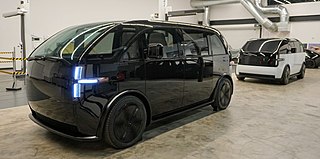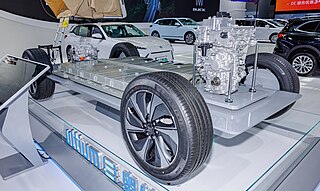
The Commuter Cars Tango is a prototype ultra-narrow electric sports car designed and built by Commuter Cars, an electric car company based in Spokane, Washington.

An electric truck is an electric vehicle powered by batteries designed to transport cargo, carry specialized payloads, or perform other utilitarian work.

Tesla, Inc. is an American multinational automotive and clean energy company headquartered in Austin, Texas, which designs, manufactures and sells electric vehicles, stationary battery energy storage devices from home to grid-scale, solar panels and solar shingles, and related products and services.

The Tesla Roadster is a battery electric vehicle sports car, based on the Lotus Elise chassis, produced by Tesla Motors from 2008 to 2012. The Roadster was the first highway legal, serial production, all-electric car to use lithium-ion battery cells, and the first production all-electric car to travel more than 244 miles (393 km) per charge. It is also the first production car to be launched into deep space, carried by a Falcon Heavy rocket in a test flight on February 6, 2018.

Mahindra Last Mile Mobility Limited, formerly known as Mahindra Electric Mobility Limited (2016-2023) and Reva Electric Car Company (2010-2016), is an Indian company based in Bangalore that designs and manufactures compact electric vehicles. The company's first vehicle was the REVAi electric car, available in 26 countries with 4,000 versions sold worldwide by mid-March 2011. Reva was acquired by Indian conglomerate Mahindra & Mahindra in May 2010. After the acquisition, the company launched the electric hatchback e2o in 2013. Today, the company sells electric vehicles in different segments – the electric sedan eVerito, the electric commercial vehicle eSupro, and the Treo range of low maintenance, lithium-ion battery-powered three-wheelers. Recently, Mahindra Electric became the first Indian car manufacturer to cross 170 million kilometres travelled on its fleet.

Coda Automotive Inc. was a privately held American company headquartered in Los Angeles, California. The company designed and assembled lithium-iron phosphate (LiFePO4) battery systems for automotive and power storage utility applications, and electric cars. Miles Automotive partnered with Hafei and Qingyuan Electric Vehicle to establish Coda Automotive as an affiliate company. The name CODA comes from the musical term for the concluding passage of a piece of music. Coda Automotive has said that it chose the name because its electric vehicle technology represents an end for combustion engine vehicles, and the start of the electric vehicle era.

The BMW i8 is a plug-in hybrid sports car developed by BMW. The i8 was part of BMW's electrified fleet and was marketed under the BMW i sub-brand. The production version of the BMW i8 was unveiled at the 2013 Frankfurt Motor Show and was released in Germany in June 2014. Deliveries to retail customers in the U.S. began in August 2014. A roadster variant was launched in May 2018. Production ended in June 2020.

The BMW i is a sub-brand of BMW founded in 2011 to design and manufacture plug-in electric vehicles. The company initially released two vehicles: the i3 all-electric car and the i8 plug-in hybrid. The all-electric iX3 SUV was released in late 2020, while iX SUV and the i4 all-electric liftback sedan followed later in 2021.

The Tesla Model Y is a battery electric mid-size crossover SUV produced by Tesla, Inc. since 2020. The vehicle was presented in March 2019 as the company's fifth production model since its inception after the Roadster, Model S, Model X and Model 3.

Lewis Electruk was a British marque of milk floats, produced by T H Lewis Ltd, a company which had close ties with Express Dairies, the London-based retail milk company. They made pedestrian controlled vehicles (PCVs) and ride-on vehicles between 1934 and 1961. The manufacturing of battery electric road vehicles was then sold on to Morrison-Electricar who continued to build two Electruk models for the dairy industry. Major purchasers of their products included Express Dairies and the London Co-operative Society.
Tomlinson Electric Vehicles was a British manufacturer of milk floats and other battery electric road vehicles, which also supplied vehicles to the Benelux countries. The company was formed in the mid-1930s. In 1949 they were taken over by King's Motors of Oxford, but the Tomlinson name was retained. They made a battery-electric railway locomotive in 1958, and hoped to diversify into this market, but were the subject of a hostile takeover by an asset stripping company in 1961, after which vehicle production ceased.

Sion is a cancelled project by the German start-up Sono Motors aimed at developing a partially solar-powered electric car. The battery was set out to be chargeable using both the electric grid as well as its own solar cells.

The Togg T10X is a fully electric C-segment SUV produced by the Turkish car manufacturer Togg. Togg started manufacturing the T10X in 2022, which is the first of five electric cars models that are planned to be produced by 2030. Deliveries started in April 2023 and as of November 2023, it was the 4th most sold car model in Turkey.
Bollinger Motors is an American automobile manufacturer of electric vehicles based in Oak Park, Michigan.

The Canoo Lifestyle Vehicle (LV) is a battery electric vehicle with multiple body styles sharing a common platform, including minivan, cargo van, and pickup truck, manufactured and marketed by Canoo. The cargo van variant, named the Lifestyle Delivery Vehicle (LDV), is in production; an all-wheel-drive pickup truck, named the Light Tactical Vehicle (LTV), has been delivered for evaluation by the United States Army; and three other models of passenger vans have been announced. They have range estimates of 400 km (250 mi) and an estimated 0–100 km/h (0–62 mph) time of 6.3 seconds.

Ultium is an electric vehicle battery and motor architecture developed by General Motors. It is being deployed for battery electric vehicles from General Motors portfolio brands along with vehicles from Honda and Acura.

The Rivian EDV and ECV are a line of battery-electric cargo vehicles built by Rivian. Initially they were exclusive to its investor Amazon, which uses the EDV for package delivery, but in November 2023, sales were opened to other companies as the ECV, with minor cosmetic changes. The EDV and ECV use the RCV platform, which is derived from the R1 platform that underpins the manufacturer's R1T pickup truck and R1S sport-utility vehicles, and is built in three sizes. Specific models include the EDV/ECV-500, EDV/ECV-700, and EDV-900.

The Workhorse C-Series was an American line of battery electric medium-duty delivery vans built by Workhorse Group for commercial package delivery company fleets, which entered limited production in 2021, were recalled that September, and were discontinued in 2022 after fewer than fifty were built. The C-Series was originally named the N-GEN when the line was first announced in 2017. N-GEN prototypes began testing in 2018 and were renamed to the C-Series in 2019.

The Arcimoto FUV is a battery-electric, three-wheeled motorcycle produced by Arcimoto since 2019. It has a top speed of 75 mph (121 km/h) and an estimated range of 102 mi (164 km) in an urban environment.

















